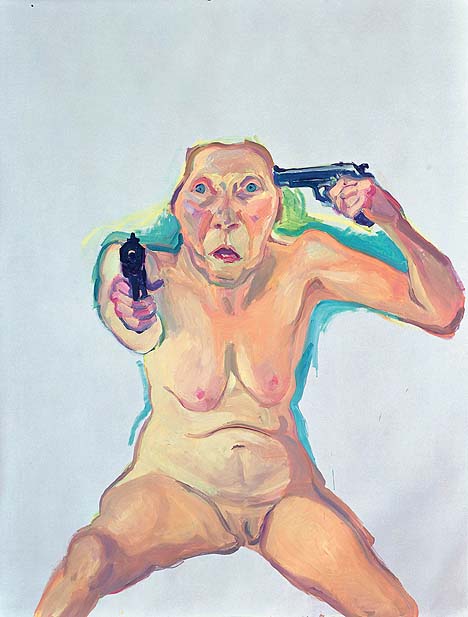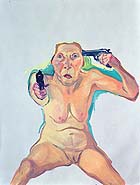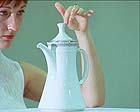
translated and summarized by: Liz Wollner-Grandville,
English summary May 26 - June 1
Serpentine Gallery: Maria Lassnig
Bodies and Affairs
What does Maria Lassnig, the Grand Dame of Austrian art, have in common with rock singer Tina Turner? Turner celebrated a tremendously successful and body conscious solo-comeback when she was nearly 60. Over the last 60 years Lassnig, now nearly 90 focused her work on “body awareness paintings”. For the first time a public gallery in the UK is showing Lassnig’s work in a solo presentation. The exhibit includes a selection of her sensational fresh and vibrant oil paintings and rarely exhibited films.
The Austrian’s work is characterized by her urge to deal humorously with such precarious topics such as war, violence, love and sexual abuse; and the depictions of these topics are merciless. In her animated films she performs as a singer and accompanies body-related narratives with her monotonous choir singing.
“Du oder ich” (you or me) (2005) her famous work depicting her nude self with a gun pointed at the audience and the other against her temple clearly shows her desire to provoke confrontation. The work is not necessarily meant to be an attack against the social environment, it could just as well be an expression of the painter’s containment towards her own, true, exalted, or narcissistic body awareness, as Robert Storr suggests in the catalogue. Antagonistic emotions are also present in other paintings such as “Eiserne Jungfrau und Fleischige Jungfrau” (iron virgin and fleshy virgin) and “Fotografie gegen Malerei” (photography versus painting). Lassnig’s style of painting is all about drawing attention to how one sees and produces one’s own personality. All of this happens beyond feminism, which is, however, always vindictively being forced onto her.
In one of the side rooms of the Serpentine Gallery Lassnig’s paintings of elderly, obese, naked, lonely men are shown in ambivalent poses and obvious sexual activities. The paintings are titled “Der Weltzertrümmerer” (the destroyer of the world, 2003), “Don Juan d’Austria” and “Bugbear”.
Her most recent works are somewhat of a surprise. The figures are painted with dark, cool colours, enveloped by shadows and their desire for death and beauty refers to a religious Christian tradition of painting. They show lovers, paradisiacal love and tenderness as well as extramarital couples. Those depicted are often seen under a transparent plastic foil, as if they were encased in a body bag – they seem more dead than alive. These prosaic distanced dramatic works come across as eccentric and yet again clearly assert the painter’s subjective approach.
Serpentine Gallery
W23XA London, Kensington Gardens, until 08.06.08
www.serpeintinegallery.org
Museum auf Abruf: Matrix, Gender – Relationships – Revisions
More or less feministic
A photo-collage framed in gold. Five men, their heads decorated with black Persian lamb hats, black suit, tie, all five lined up, all direct their eyes at you. It doesn’t take much to figure out that they all depict the same man. And those who are familiar with the Viennese art scene of 1991 will identify the man as the artist Friedrich Eckhardt.
Eckhardt poses with dignity in this photo collage “Die Gilde” and thereby forms a kind of ironic welcome committee to a topical cross-section of four decades of art history, focusing on Vienna and its surroundings as well as the gender topic. The latter was the leitmotif around which the curators Sabine Mostegl and Gudrun Ratzinger based their selection of works from the City of Vienna’s contemporary art fund.
The exhibit reflects the story of feminism, and is clearly dominated by female artists. The exhibit shows works by Valie Export, Renate Bertlmann, Birgit Jürgenssen, Friedl Kubelka-Bondy and younger artists ranging from Carola Dertnig, Ines Doujak, Maria Hahnenkamp, Ilse Haider to Elke Krystufek, Michaela Pöschl and Katrina Daschner. It is the ideological downside of this controversy with regard to power, norms, ideology and sexuality that the number of works by male artists is rather minimal. Besides Eckhardt the artist Matthias Hermann stands out, with his text-picture series, in which he takes a close and ironical look at heterosexual norms – “one of the things I always ask my students is how their heterosexuality influences their work”, 1997. While Edgar Honetschläger’s black and white series “Boden voller Sinn” (grounds full of meaning) alludes to Valie Export’s “Körperkonfigurationen” (body configurations), showing the naked body merging with the landscape, Lois Renner’s work does not have much connection to the show’s topic. His early “Ateliereinsicht (mit P.P. Rubens)” 1995, enjoys an artistic status and a genial reputation, but has little to do with social “matrices”.
Works dealing with skin and clothing allow the curators to succeed in bringing the most conclusive argumentation to the onlooker. Skin symbolizing the vulnerable border between the individual and the outside world, and clothing resembling the cover and security layer as well as a representative media for information. Magda Tothova’s textile object “Windstoß” (gust of wind - 2006) creates a strong exuberant mix – a pleated white skirt with reference to Marilyn Monroe’s sex appeal, the underwear covered with Lenin medals – clearly showing the government’s power - even in the most intimate parts. Maria Hahnenkamp’s “rote genähte Fotoarbeiten” (photo works sewn in red 1995) narrate the story of being easily hurt and going to the absolute limit.
The media of photography – dependent on an apparatus (even more so than video) proves itself as a key medium of feministic art. Not only as a documentation, but also as a picture, which incorporates a dialogue and a process – both of which play such a central role in feministic art.
Museum auf Abruf
1010 Vienna, Felderstrasse 6 – 8 , next to the Rathaus (town hall) until 07. 06. 2008
www.musa.at
MUMOK-Museum moderner Kunst: Runa Islam – Empty the pond and get the fish
We live on dead fish
With the first motion picture , perfect illusion came to being. Time could be ‘caught’ by an apparatus and the elapsed time could be shown over and over again. Keep everything moving – until artists like Runa Islam dealt with this illusion – by means of the media of film.
Her three movies currently shown at the MUMOK range from a documentary, a cinematic analysis of an empty building to a drama with the title “Be The First To See What You See As You See It.” The drama begins with an intent view on seemingly precious porcelain, and then develops into a sensuous touch. (And as if this tenderness crosses the border, which only permits loving proximity to be observed at a distance), Runa Islam lets the viewer watch how the porcelain falls to the floor in slow motion and break into hundreds of pieces. The technical process of the film re-translates the story of the woman and her dishes – after all: film also cuts reality into fragments. However, the film in the form of dishes can never be assembled again without noticing the difference – something even super-glue could not accomplish. Goodbye, beautiful illusion.
In the third picture, a camera is shifted as if one would be writing with it: like a pen the camera writes a message in the form of a film. The camera slips the world a text about the world, which in turn originated in a different world. But one could not accuse Runa Islam of mixing up the facts - reality is probably always being planted everywhere. The title “Empty The Pond To Get The Fish” refers to a fishing-method, but to Runa it is also a description of how a film is produced: emptying the water out of pond, until only dead fish, dead pieces of reality are left over. Gruesome. Tragic. But if we reach out to fish in the first place, don’t we mainly live on dead fish?
MUMOK – Museum moderner Kunst
1070 Vienna, Museumsquartier until 13. 07. 2008
www.mumok.at
Galerie Peithner-Lichtenfels: stARTbox: Tanja Boukal
Humans are the benchmark
The value of recognisability, the artist’s individuality in art becomes impressively apparent in Tanja Boukal’s current exhibit in the second basement of the Gallery Peithner-Lichtenfels. The young artist skilfully reacts to the unique exhibition space and even integrates the ventilation windows into her work. White plaster busts and babies knit of white wool are found standing, lying, or hanging everywhere in this room. The artist succeeds in giving this space a unique tone, mainly because she not only addresses but very consciously reacts to the given situation.
Her work is involved with basic topics of human life, without being platitudinous or declamatory. The knitted couch blankets, on which sleeping humans are depicted, are a good example of how everyday culture and art flow into each other. One can clearly feel that humans are the highest benchmark – even in the arts.
Galerie Peithner-Lichtenfels
1010 Vienna, Sonnenfelsgasse 6, until 07.06.2008
www.peithner-lichtenfels.at
Mehr Texte von translated and summarized by: Liz Wollner-Grandville


 Teilen
Teilen




